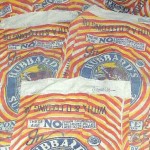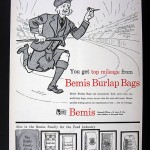A Brief History of Advertising Textile Bags
I prefer to use the feed, seed, rice, and fertilizer type sacks which instead of a cotton pattern have the manufacturer’s logo, graphics, and information about the product the bag contained. These sacks were made in a variety of fabrics from thin muslin to loose-woven burlap.
– The following is an excerpt from “A Brief History of the “Feedsack““ by Jane Clark Stapel
The terms “feedbags” or “feedsacks” are not totally accurate. According to Anna Lue Cook in her book Textile Bags –The Feeding and Clothing of America, the 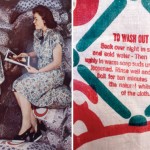 flour industry consumed the largest share of the feedsack market with more than 42 percent, sugar was next with 17 percent, behind that were feed, seeds, rice, and fertilizer. Some people refer to these utilitarian bags as simply textile or cloth bags, chicken linen, or ‘pretties’. The loosely woven early bag was displaced when machinery became available and, as the trend for cloth packaging became more popular, a tighter cotton bag was more commonly used. When the product inside was used up, the frugal housewife, who wasted no scrap of cloth that came her way, was soon recycling the bags.
flour industry consumed the largest share of the feedsack market with more than 42 percent, sugar was next with 17 percent, behind that were feed, seeds, rice, and fertilizer. Some people refer to these utilitarian bags as simply textile or cloth bags, chicken linen, or ‘pretties’. The loosely woven early bag was displaced when machinery became available and, as the trend for cloth packaging became more popular, a tighter cotton bag was more commonly used. When the product inside was used up, the frugal housewife, who wasted no scrap of cloth that came her way, was soon recycling the bags.
– The following is an excerpt from “Vintage Fabrics – IN SEARCH OF WARP ENDS“ by Joan Kiplinger
Up until the mid-1800s, storage containers were primarily wooden barrels, boxes, tins and to some extent, pottery. It was the abundant source of cotton from the South which enabled the transformation to cotton bags for flour, sugar, meal, grain,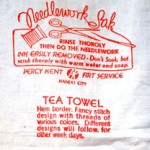 salt and feed. Eventually this led to the births of industries for weaving bag cloth, manufacturing bags and developing inks suitable for printing on textiles, not to mention those handy with words to come up with catchy advertising .
salt and feed. Eventually this led to the births of industries for weaving bag cloth, manufacturing bags and developing inks suitable for printing on textiles, not to mention those handy with words to come up with catchy advertising .
The early bags prior to 1850s were handsewn, handmade and usually bore an identifying handstamp of the individual taking it to the gristmill. With the introduction of sewing machines, bag manufacturing and sales increased although were still too expensive for most companies to purchase. As late as the 1880s barrels were still the preferred storage unit but by WWI they had all but disappeared.
Once established, bags were produced in varying sizes from one pound for household use to those 12 feet long for picking cotton. The original sizes corresponded to barrel measurements for a pound to 1/8 pound of flour. In 1943 bags were standardized into six sizes ranging from 100 pounds to two pounds by order of the War Production Board.
It was the depression which created a real demand for bags as frugal housewives discovered they could reuse and recycle them. Empty bags were prey for conversion into boys underpants, children’s clothing, aprons, dresses and everything else imaginable.
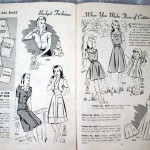 To accommodate the little lady as well as sidle in a great marketing ploy, manufacturers added figured and dress prints to the whites, browns and other solid colors of earlier manufactured bags. Some bags came ready for sewing with doll patterns printed on one side or sewn-in drawstrings that when one seam was ripped produced an instant apron; others were specifically printed for pillow cases or curtains. Pattern companies issued appealing booklets for sewing attractive garments and how to care for sacks. A 1942 estimate showed that 3 million women and children of all income levels were wearing print feedbag garments.
To accommodate the little lady as well as sidle in a great marketing ploy, manufacturers added figured and dress prints to the whites, browns and other solid colors of earlier manufactured bags. Some bags came ready for sewing with doll patterns printed on one side or sewn-in drawstrings that when one seam was ripped produced an instant apron; others were specifically printed for pillow cases or curtains. Pattern companies issued appealing booklets for sewing attractive garments and how to care for sacks. A 1942 estimate showed that 3 million women and children of all income levels were wearing print feedbag garments.
After WWII, new technological innovations and increased family budgets affected society’s spending habits. More sanitary and effective packaging, less prone to rodent damage, were demanded, leading to heavy paper and plastic containers. By 1948 this new industry cornered 53% of the bag market and the cloth bag fell out of use.
